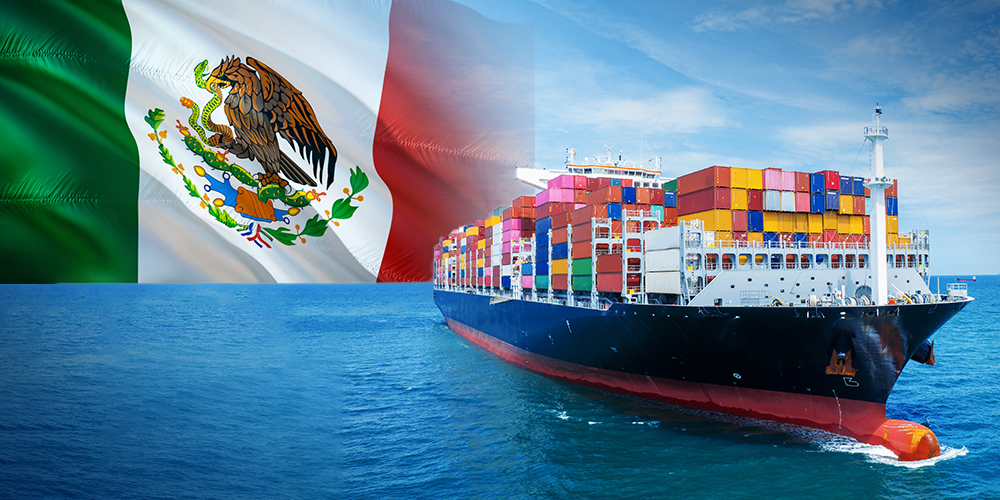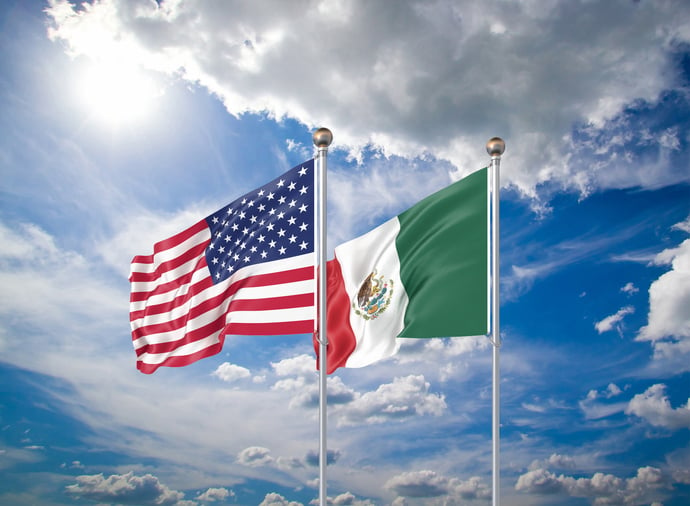Cross-border freight isn’t just a cost center—it’s become a growth channel. Mexico was the United States’ top trading partner in 2024 with about $840B in total goods trade, underscoring how vital reliable US–Mexico logistics are to modern supply chains.
This guide breaks down how to ship freight over the Mexico border—from documents and customs to mode selection, drayage, and temperature-controlled options—so you can move with confidence.
Shipping Freight Across the Mexico Border
Shipping freight across the Mexico border involves multiple transportation modes, such as road, rail, air, and sea. Each mode comes with its advantages and considerations, depending on the type of cargo, urgency, and budget. Road transportation is commonly used for short distances and offers flexibility in reaching various destinations. Rail transport is a cost-effective option for moving large volumes of cargo over longer distances. Air freight is suitable for time-sensitive shipments, offering speedy delivery. Sea transport is ideal for large shipments with longer lead times and offers cost-effective solutions for bulky goods.
Beyond standard shipments, businesses often need specialized solutions for oversized or overweight cargo moving across the Mexico border.
Solutions for Oversized and Overweight Cargo
Handling oversized and overweight cargo requires careful planning, specialized permits, and the right equipment. Whether it’s industrial machinery, construction equipment, or bulk materials, shippers must comply with both U.S. and Mexican regulations to ensure safe passage.
Partnering with experienced carriers helps businesses ship freight to Mexico without delays. These providers understand permit requirements, secure the right trailers, and plan efficient cross-border routes. By working with a logistics partner who specializes in heavy-haul freight, businesses reduce risks, maintain compliance, and guarantee safe delivery of oversized loads.
Essential Requirements for Cross-Border Transportation
To ensure smooth cross-border shipping, businesses must adhere to essential requirements and obtain the necessary permits and documentation. One of the key documents required for shipping freight over the Mexico border is the Pedimento. This document serves as a customs declaration and includes details about the shipment's value, origin, and destination. It is essential to provide accurate and comprehensive information in the Pedimento to avoid delays and penalties during customs clearance.
Additionally, businesses must prepare a commercial invoice, which provides a detailed breakdown of the goods being shipped, their value, and other relevant information. This invoice helps customs officials assess the shipment's dutiable value and determine applicable tariffs and taxes. In some cases, a certificate of origin may be required to verify the country of origin of the goods and ensure compliance with trade agreements and preferential tariff programs.
Documentation and Customs Procedures
Navigating customs procedures is a critical aspect of shipping freight over the Mexico border. It involves submitting accurate and complete documentation to facilitate customs clearance. Failure to provide the correct information can lead to delays, fines, or even the confiscation of goods. Working with experienced customs brokers and logistics partners can help businesses stay up-to-date with changing regulations and ensure compliance.
Once documentation is in order, businesses must decide how shipments will move across the border — directly or through trans-loading.
Managing Direct and Trans-Loading Shipments in US-Mexico Freight
Choosing between direct shipments and trans-loading isn’t just about cost — it’s about aligning the method with your cargo’s needs. The right strategy ensures businesses can ship freight to Mexico with fewer risks, greater efficiency, and better overall control of supply chain outcomes.
- Direct Shipments: Cargo stays in the same trailer from origin to destination. This reduces handling but may cost more.
- Trans-Loading: Goods transfer to another trailer at the border. This can reduce costs and meet equipment standards, but adds an extra step.
For companies that regularly ship freight to Mexico, trans-loading can create efficiencies. However, fragile or urgent cargo may be better suited for direct shipments. A reliable logistics partner helps determine the best option by balancing speed, cost, and cargo safety.
Selecting the Right Transportation Mode and Carrier
Selecting the appropriate transportation mode and carrier is pivotal for successful cross-border shipping. Businesses should carefully assess their shipping needs, budget, and delivery timelines to choose the best option. For time-sensitive shipments, air freight may be the preferred choice, while rail and sea transport are suitable for bulkier shipments with longer lead times.
When selecting a carrier, it is crucial to partner with a reliable and experienced logistics provider that specializes in cross-border transportation. An experienced carrier can navigate the complexities of customs procedures, border crossing protocols, and transportation regulations, ensuring that the freight reaches its destination safely and on time. Additionally, a reputable carrier will offer tracking services to provide real-time updates on the shipment's status, enabling businesses to keep their customers informed and maintain transparency throughout the shipping process.
Some industries need more than speed — they require reliable temperature control to protect goods in transit.
Temperature-Controlled Shipping Options
Here are three options businesses use to ship freight to Mexico safely with temperature-sensitive cargo:
- Refrigerated Trucks (Reefers): Keep goods such as food or pharmaceuticals within required temperature ranges.
- Insulated Containers: Protect against external temperature fluctuations during longer transit times.
- Real-Time Monitoring Systems: Provide visibility into temperature data, ensuring cargo stays compliant throughout the journey.
These solutions help businesses reduce spoilage, maintain quality, and strengthen customer trust.
Beyond trucks and paperwork, it’s expertise that makes the biggest difference in cross-border logistics.
Experience and Expertise in US-Mexico Freight Shipping
Logistics providers with deep experience in US-Mexico freight shipping bring three major benefits:
- Fewer Delays: Anticipating customs issues before they arise.
- Lower Costs: Identifying efficient routes and negotiating competitive rates.
- Stronger Compliance: Understanding regional rules and documentation requirements.
With an experienced partner, businesses ship freight to Mexico with confidence, knowing their logistics strategy is backed by proven expertise and local knowledge.
Border Crossing Protocols
Border crossing can be a potential bottleneck in the shipping process. To ensure smooth and efficient shipping, businesses should be prepared for the border crossing protocols and potential delays. One essential aspect is to comply with the regulations set by the Mexican customs authorities. Non-compliance can result in delays, fines, or even the confiscation of goods.
Working closely with customs brokers can significantly expedite the border crossing process. These professionals are well-versed in customs regulations and can assist businesses in preparing accurate and complete documentation for customs clearance. They also act as intermediaries between businesses and customs officials, ensuring that all requirements are met and potential issues are addressed promptly.
Shipment size and weight directly affect cost, timing, and compliance at the border.
Understanding Weight and Size Limits: FTL, LTL, and Partial Truckload
Knowing when to choose FTL, LTL, or partial truckload can make or break cross-border efficiency. With the right planning, businesses can ship freight to Mexico cost-effectively while staying compliant with weight and size limits.
- Full Truckload (FTL): Best for large shipments that fill an entire trailer. Direct transport means fewer touchpoints and less risk.
- Less Than Truckload (LTL): Smaller shipments share trailer space. Costs are lower, but more handling is required.
- Partial Truckload: Works for mid-sized shipments, offering cost savings without needing a full trailer.
Understanding these categories ensures businesses can ship freight to Mexico efficiently while avoiding fines or rejected loads due to weight or size restrictions.
Your Partner for Cross-Border Logistics
Partner with Visigistics for your cross-border logistics needs. As a trusted logistics partner, we provide comprehensive solutions designed to simplify the challenges of shipping freight over the Mexico border.
Our experienced team ensures compliance with customs regulations, streamlines border crossing procedures, and optimizes supply chain efficiency to meet your unique business requirements.
Contact Visigistics today to learn how we can tailor logistics strategies to your specific shipping needs and experience the benefits of seamless cross-border logistics.





.png)